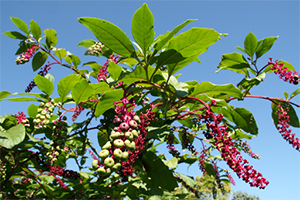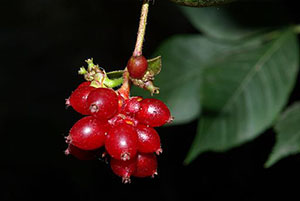Making Homemade Ice Cream This Summer? Know Your Berries!
Making Homemade Ice Cream This Summer? Know Your Berries!
By Bill Willis
June, 2016

Photo courtesy of Huw Williams
Fresh fruit ice cream during the heat of summer… what a refreshing thought.
Why not make your own “Yard Berry” delight from the fruit in your landscape? No ice cream truck to deal with, and you can be as adventurous with the recipe as you want. After all, who hasn’t been tempted to grab a berry off the bush and pop it into their mouth?
Not so fast, my friends. Let’s take a few minutes to fully evaluate and appreciate this “DIY” approach.
Not all berries were made equal, or healthy

Photo courtesy of David Perez
Looks can be deceiving, and potentially lethal, as forbidden fruits are all around us. We were told not to pick and eat mushrooms, for they could be deadly. But what about berries? What were we told about their safety?
Sadly, probably not much.
Here are a few things to remember when berry picking this season.
Ground Rule 1: When in doubt, avoid it
If you’re not certain whether a particular plant or species is safe to eat, then do yourself a favor — don’t. Besides the possible toxins that may be inherent in the species, individuals may have their own sensitivities to the plant that they never even knew about.
Ground Rule 2: Stay away from the spray
It’s also wise to avoid consuming recently herbicide sprayed roadside plants. The health effects associated with such products are obviously well-chronicled. However, they can be particularly potent when first applied to the fruit.
Ground Rule 3: What’s good for the goose isn’t always good for the gander
Just because a bird or other animal is seen eating a type of fruit doesn’t necessarily mean it’s safe for humans. Think about it. Is everything from your dinner-table good for your pet? That street runs both ways.
A great resource is coming soon to a library near you
The St Lynn’s Press, Pittsburgh has just released a book from local author, Helen Yoest, titled Good Berry, Bad Berry: Who’s Edible, Who’s Toxic, and How to Tell the Difference. It’s a great read, and one that’ll soon be available for checkout from the NIEHS Library in the Rall building.
The following are a few of the berries that Yoest recommends we leave alone. Bear in mind, this isn’t a complete listing of all harmful berries/fruits in North Carolina, but it’s a great start for anyone turning to nature for their cooking ingredients this summer.
Bad Berries to Avoid
- Bittersweet – (Oriental Bittersweet)- alkaloids
- Cotoneaster – (Cotonaster) - cyanogenic glycoside
- Honeysuckle – (Common Honeysuckle) – carotenoids
- Ligustrum – (Privet) – glycosides: syringin, shikimic acid
- Nandina – (Heavenly Bamboo) –hydrocyanic acid
- Nippon Lilly – (Japanese Sacred Lilly) – cytotoxic and cardiotonic
- Pokeweed – (Poke) – phytolaccine, phytolaccatoxin, phytolaccigenin
- Solomon’s Seal – (Polygonatum) – convallamarin
- Spotted Laurel – (Aucuba) – aucubin
- Strawberry Bush – (Hearts a Busting) – glycoside?
- Tutsan, Hypericum - (St. John’s wort) – xanthones?
- Virginia Creeper – (Friendly Five Fingers) – oxalic acid
- Winterberry Holly – (Holly) – theobromine
Other “Bad Berry” honorable mentions from around the southeast
- Castor bean
- Daphne sp
- English Ivy
- Jasmine
- Jerusalem cherry
- Lantana
- Moonseed
- Partridgeberry
Happy churning, everyone!
(Bill Willis is a biologist with NIEHS and a member of the institute’s Site Ecology Team.)



